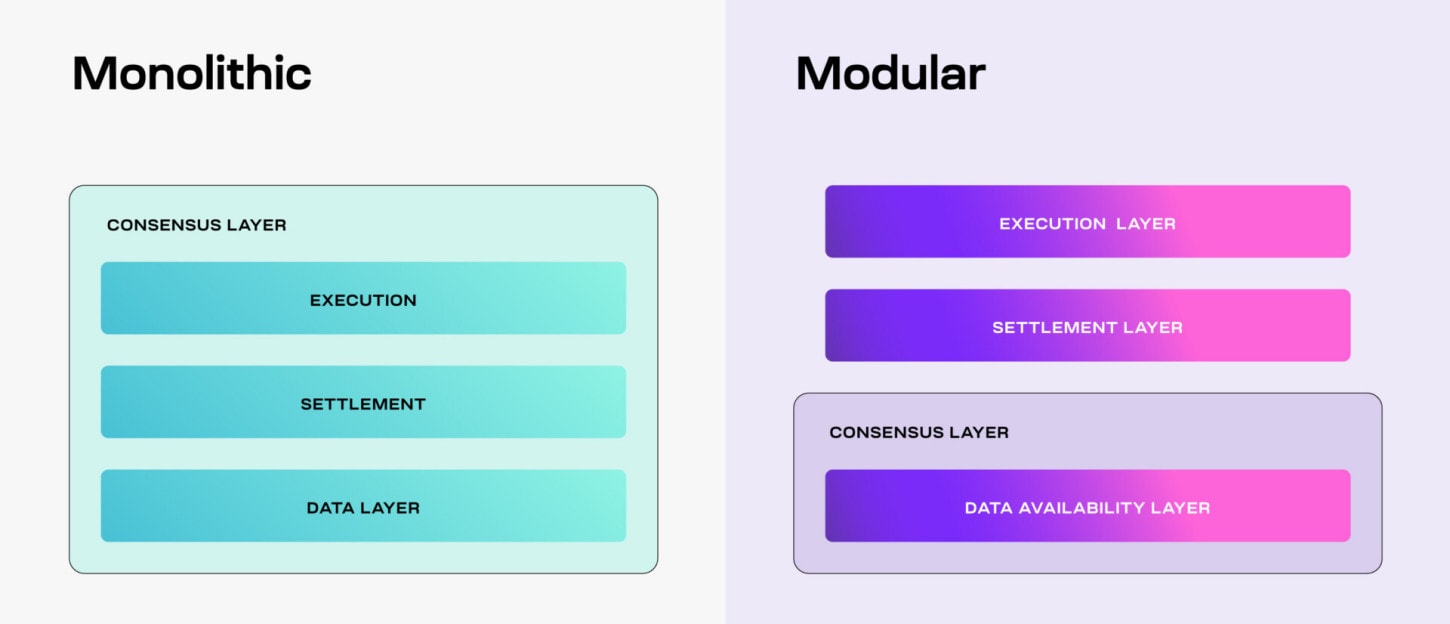Celestia, Avail or EigenLayer, many projects offer Data Availability Layers, also called data availability layers. In practice, these protocols are one solution among many to improve the scalability of blockchains. Let’s explore together what they are and how they work.
The era of monolithic blockchains
Bitcoinas well as most layer 1 blockchains are so-called monolithic blockchains. In practice, this means that all functions and operations are executed on a single chain.
Concretely, a monolithic blockchain manages three main components:
- Execution;
- Consensus ;
- Data availability.
From the creation of transactions, to their addition in a block until the validation of the blocks, all the mechanisms are managed on the main layer of the blockchain.
Thus, in this type of architecture, each node of the network must process all of the operations.
As cryptocurrencies grow, this architecture quickly showed its limits. As monolithic blockchains manage all operations on the backend layer, this leads to limitations. Particularly in terms of scalability and performance.
Faced with this problem, several avenues have been explored. For example, the Solana blockchain has chosen to maximize performance.
However, this comes at the expense of centralization. Indeed, like all the nodes in the network must be able to process all possible operations. That implies that each node has high hardware requirementseffectively raising the entry barrier to operate a node on the network.
Thus, some developers have imagined more modular architectures. The objective being to separate each of the three main components of a blockchain in a specific and dedicated layer.
The advent of modular architecture
Unlike the monolithic approach, for which one layer manages all operations, developers focused on a more modular approach.
Thus, the different components of the blockchain are divided into different layers. Each of these layers is responsible for managing one of 3 components: execution, consensus or data availability.

For example, during the transition to Proof of Stake, Ethereum moved from a monolithic blockchain to a two-layer blockchain with:
- The execution layer, responsible for executing transactions and smart contracts;
- The consensus layer, responsible for the coordination and validation of blocks.
Faced with the growth of this architecture, developers have imagined a more modular architecture.
The problem of data availability
Before going into detail about Data Availability Layers (DA layers), we must first understand the data availability problem.
Let’s go back to the basic functioning of a blockchain. When a node must validate a block, it will check the validity of each of the transactions present in this block. To do this, he will need to know the details of each transaction.
Therefore, it is essential that transaction details are accessible to all nodes so that they can validate transactions. However, forcing all nodes to download all data creates significant limitations in terms of scalability. As explained on the official Ethereum website:
“Complete transaction data is required to independently verify blocks. However, requiring all nodes to download all transaction data poses a barrier to scaling. »
Furthermore, this problem takes on a whole new dimension with the arrival of L2 and other rollups. In fact, the rollups must also publish data relating to transactions that take place on the L2. These are necessary so that any external observer is able to verify the proof of state published by the rollup on the L1.
As a result, chains like Ethereum find themselves having to store data from transactions taking place on both L1 and L2. This unsurprisingly creates limitations in terms of scalability.
Data Availability Layer: the solution to data storage
So far, most rollups use Ethereum’s L1 to publish transaction data. Therefore, we can say that Ethereum is the data availability layer of most rollups.
However, faced with the rise of modular architectures, several projects have emerged in offering blockchains specialized in data accessibility. So, rather than publishing transaction data on the L1, rollups can use these solutions to publish the data.
The mission of these new layers is simple: verify that each block has been added by consensus and that new blocks are available to the network.
Among the most popular projects in the field of DA we find Celestia, Avail or EigenLayer. In fact, each of these solutions approaches the problem differently and has its own mechanisms to ensure that the data is available.
The disadvantages of DA Layers
Obviously, like any technological solution, DA Layers do not only have advantages.
Thus, the latter effectively make it possible to improve scalability, but often at the detriment to security. Indeed, as the data is no longer stored on the L1, this data and the rollups no longer fully inherit the security of Ethereum.
Furthermore, as Vitalik Buterin discussed last January, rollups that use a data accessibility layer are not strictly speaking rollups but validiums.
Consequently, each project must make the choices that seem judicious to it, taking into account the disadvantages and advantages offered by each solution.
For its part, the Ethereum network is poised to become a better data availability layer for its L2s. Indeed, the Next March 13, the Cancun Deneb update should be deployed on the mainnet. This will introduce Proto-Danksharding, a new, more efficient method for storing L2 data on Ethereum.
